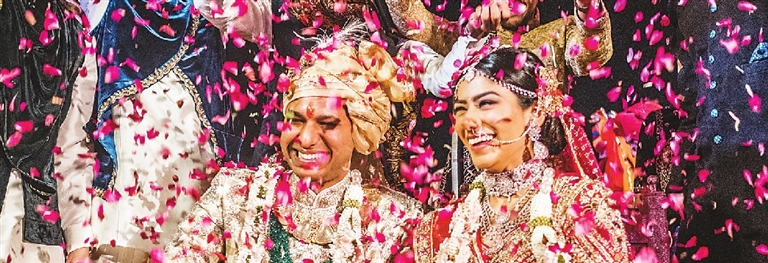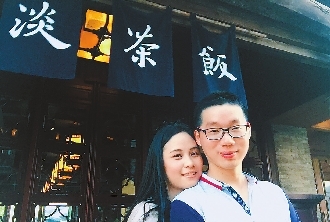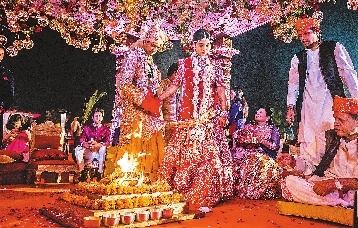


Chen Xiaochun 654789759@qq.com THIRTY-YEAR-OLD Gurpreet Singh Bahri from India has been living in Shenzhen since 2012. When I first met him, something about him made me feel close and comfortable, which I didn’t notice at the beginning. As our conversation went deep, I came to realize it is his Mandarin with the typical Chaoshan accent that drew me in. He must have picked it up from the many friends and business partners he has from the Chaoshan region, my hometown. Located in the east of Guangdong Province, facing the South China Sea, Chaoshan encompasses three administrative cities — Chaozhou, Shantou and Jieyang — and has a distinct dialect and culture. Chaoshan people, who live along Guangdong’s eastern seaboard, are more traditional in love and marriage values. This area is one of those in China that enjoy the lowest divorce rate. Chaoshan girls have the fame of being the best wife for a husband for their virtues, kindness, hard-working attitude and obedience, while Chaoshan guys are often labeled with male chauvinism. Businessman Bahri said that there are many similarities between Chaoshan people and Indian people regarding family values, marriage, business, food, and other traditional practices. “Indian people and Chaoshan people both have the most respect for their parents. Chaoshao people respect the elderly a lot. They always put their family first,” said Bahri, who added that the marriage values between the two also share similarities. “Many Chaoshan parents love to arrange marriages and usually introduce the girls and boys to each other.” Women’s role in the family “In India, when people marry, women go to live in men’s house. In early times, it was men’s role to support the family financially, and women’s role was to look after the family. But in the changing modern world, lots of women join the workforce and grow more economically and socially independent, more ambitious and serious towards education,” explained 35-year-old Deependra Kothari, who works for a jewelry company in Shenzhen. “A few years ago, it was very common for a woman to become a housewife. But now with higher education levels, daughters enjoy more freedom, and more understanding is reached in the family that a girl goes outside to work,” said 35-year-old Abhishek Daga. Daga added that in Indian cities, around 50 percent of the women are working, while in villages, 90 to 95 percent are housewives. According to statistics of the 2011 census released by the Indian Government, the female literacy rate in India has made remarkable strides, reaching 64.63 percent in 2011, gaining 10.96 percentage points in 10 years’ time. Gender disparity in literacy rates in India declined by 5.34 percent points from 21.59 in 2001 to 16.25 in 2011. There has been a continuous decrease in the gender gap in literacy since 1991 (24.84 percent). That probably explains the gradual change of women’s role from housewives to workers. Like their Indian counterparts, women in Chaoshan also dedicate more of their time to family life, thus earning themselves the title of being the best wives in China. He Chuhong, 27, comes from Jieyang and married a girl from the same region. For He, the saying that “Chaoshan men are macho and Chaoshan women are virtuous” is only a one-sided view. He prefers to interpret it as “Chaoshan men are more family-centered and women good at maintaining the family.” “I believe every Chinese man hopes to become a major breadwinner,” said He, adding that however, he doesn’t want his wife to sacrifice work for family life. Wang Peiling, 26, from Jieyang, works in a renowned technology company in Shenzhen. In her opinion, sometimes Chaoshan women are “forced” to be virtuous and she personally doesn’t like that word. However she also agrees that Chaoshan women do dedicate more to their family life. “It’s like these kinds of thinking are embedded in their sub-consciousness. They take it for granted that it’s women’s duty to do housework and everything,” Wang said. “Sometimes when their husband gives a hand, they feel super grateful. They don’t have the idea that it is also the husband’s responsibility.” As more and more Chaoshan girls receive higher education and work professionally, their roles within the family seem to have changed. For the younger generation like Wang, both sides should have income, otherwise there are risks. “If something happens to the husband and the family doesn’t have any other income, it’s very risky,” she said. Boys or girls In terms of children, Bahri said Indians do prefer boys, but if they have both, there are not different requirements between genders. Deependra Kothari said that in India people are happy with both boys and girls. However, in small towns and villages, people do prefer boys over girls, especially if they have only one child. “I have two sisters, both of whom are elder than me. For my parents, we three are equal from the first day. Nowadays it’s okay to have only one daughter. My second sister only has one daughter and she is very happy with her,” said Daga. In this respect, Chaoshan people share similar values. For Chaoshan people, more kids represent more blessing, and boys are important for carrying on the family line, especially in rural areas. But things are changing day by day. Twenty-eight-year-old Zhuang Caiyu commented that their parents are also adopting new ideas via TV and the Internet and have also changed their minds on the matter. Now it’s more like a transition period. Everyone is different. Choice of life partner “My family was shocked when I told them I was going to marry a Chinese girl. Because we belong to totally different cultures, different countries, even the languages are different,” said Daga who grew up in a family of Jain culture, which practices a strict vegetarian diet. He married a Chinese girl he met at work. Daga told Shenzhen Daily that a few years ago, most marriages in India were arranged. Nowadays, young people are more open-minded. They study with each other in universities and come to know each other more. “These days, even parents and family members are accepting love marriages. So now they’re becoming more common.” Daga explained that in his culture, roughly 30 percent of marriages are determined by the partners independently and 70 percent are arranged. “In terms of love marriages, there is no boundary of social levels, because you can like anybody. But in arranged marriages, it’s more often that the level is equal.” Love marriages are more commonly accepted in Chaoshan region than in India, though parents still tend to arrange marriages for their children if the young fail to find a partner by a certain age. It’s true that some Chaoshan parents do require their children to marry someone from the same region. However Lai said that she didn’t limit her choices to Chaoshan men when selecting her life partner. “People from the same place tend to share growing experiences. It’s easier for them to understand and respect the culture and tradition of each other,” said Lai. Young Indians keep old traditions Though many of the young generation in India receive higher education and sometimes work overseas, most of them still preserve the tradition of having traditional weddings in their own country. Couple Sukriti Kothari and Pragun Jindal Khaitan are a good example. Kothari, the granddaughter of Navrattan Kothari who is the chairman of age-old KGK Group, graduated from New York University and worked in Hong Kong for their family company before getting married, while Khaitan, a graduate from Wharton School of Business, University of Pennsylvania, joined his family business in India after completing his studies overseas. A grand wedding ceremony was held for the couple in Jaipur, Rajasthan at the end of November last year, gathering around 3,000 guests, including some 700 from other countries around the world, to experience a traditional Indian wedding. The wedding, full of color, fervor, joy and celebrations, lasted for three days with different customs and rituals performed on different locations, ranging from Mehndi and Baraat to seven pheras, just to name a few. Traditions evolve with time but still hold the magic that endears a place to its people. The couple, though educated overseas, feels strongly about the place they grew up in and are proud to remain connected to their hometown in order to nurture the value system they believe in. Tradition brought them back to India for a Supra wedding. | 
